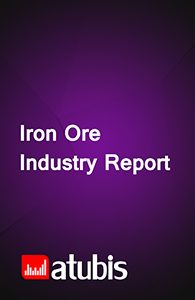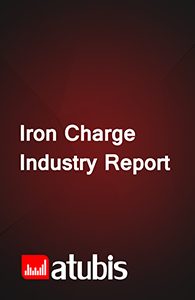Saudi Arabia’s Iron Ore Fine and Concentrate Market Outlook Report
9,768€
- TRY: 475,000 ₺
Iron ore from mines generally has a grade below 50%; using it to produce crude steel, although technically possible, incurs high production costs and the economy is annulled due to the low recovery rate. Thus, most steelmakers use iron ore with grades above 60% to economically justify their operations. Iron ore processed to be used in the steel chain is in either of two forms: fine, and concentrate. Moreover, iron ore can be divided into magnetite and hematite ore depending on ore type. The easier processing of magnetite iron ore to remove deleterious elements has resulted in higher premiums for this type of iron ore on the market.
Product Description
With a GDP of over $793 billion in 2019, Saudi Arabia was the largest economy in the region that year. The country’s economy, the second richest country in terms of natural resources, is heavily dependent on oil, its main natural resource. But since the introduction of the 2030 Vision in 2016, the country has determined to minimize oil reliance. Saudi Arabia is the third largest producer of crude steel in the region, behind Turkey and Iran. Owing to the abundant availability of natural gas, steelmakers use direct reduction in EFs to produce steel. However, with the increasing volume of ferrous scrap in the Arab states of the Persian Gulf, the share of scrap in the country’s steelmaking feed has increased.
Market drivers of Saudi Arabia’s iron ore fine and concentrate
Saudi Arabia’s steel industry relies on minerals including iron ore to produce steel; despite the significant growth in the share of ferrous scrap in the steelmaking feed over the recent years, over 60% of the country’s steel output still comes from mineral sources. Thus, as steel output increases, demand for iron ore fine and concentrate will improve.
Although there is massive potential demand for iron ore fine and concentrate in Saudi Arabia, the lack of sufficient pelletizing capacities as well as the tight availability of these products has impeded the actualization of said demand, prompting most iron ore pellet consumers to import the material. Generally, the size of Saudi Arabia’s iron ore market is the main limiting factor. The country does not have rich reserves of iron ore and at the same time, the domestic market size makes it difficult to secure small cargoes of iron ore with China dominating the market as a large buyer. As a result, the country’s steel industry has resorted to importing iron ore pellets, a product with higher added value. Saudi Arabia’s steel market is not likely to grow significantly, so the limiting factor is expected to persist.
Most of the country’s mines are small-scale, translating into higher production costs relative to other mines in the world. Over the recent years, disruptions in the global supply of iron ore have supported prices, with many iron ore mines in Saudi Arabia moving into positive margins. However, many analysts have forecast a decline in iron ore prices over the coming years due to weaker purchases by China. This can cause further contraction in Saudi Arabia’s iron ore supply in the long term.
Overview of Saudi Arabia’s iron ore fine and concentrate market
Saudi Arabia’s largest iron ore mines have hematite ore, which is costlier to process. Iron ore mining in the country already has very low margins due to the small scale of its mines. However, since most iron ore miners are integrated steelmakers, the low profit margins are justified. Given the possibility of the discovery of large iron ore reserves due to the country’s geological conditions, the situation is expected to remain as it is over the coming years. But as Chinese purchasing weakens over the long term, producers of iron ore pellets in Saudi Arabia will find an opportunity to secure the material from foreign markets so that they can buy their required volume by offering higher premiums than their rivals.
Breakdown of Saudi Arabia’s iron ore fine and concentrate market
Saudi Arabia’s iron ore market is analyzed separately for iron ore fine and concentrate. Iron ore fine commonly comes in grades of about 58%, while concentrate grade is about 65%.
Key players in Saudi Arabia’s iron ore fine and concentrate market:
- Saudi Arabia Iron Ore (SAIRON)
- National Mining Company of Saudi Arabia
- Al-Ittefaq Group
Additional Information
| Industry | Fine Iron Ore, Iron Ore Concentrate |
|---|---|
| Region | Saudi Arabia |
| Report Type | Industry Report |
Specifications
| Report Attribute | Details |
| The base year for estimation | 2019 |
| Historical data | 2009-2018 |
| Forecast period | 2020-2025 |
| Quantitative units | Value in USD and Volume in Tonne |
| Report coverage | Market Overview, Dynamics, Market Outlook, Risks to Forecast, Consumer Market, Industry Overview, Market Landscape, Competitive Landscape, Market Attractiveness, External Macro Environment Analysis |
| Segments covered | Source, Composition, Type, Application |
| Pricing and purchase options | Please explore our purchase options to meet your exact research needs. |
Reasons to Buy
- Recognize the geographical distribution of import demand
- Identify the current and future key players of the trading market
- Achieve a better insight on potential target markets
- Understand the behavior of major suppliers/customers either globally or regionally
- Identify competitors as a feed for market analysis
Table of Content
- Executive summary
- Introduction
- Objective
- Market under study
- Product
- Product specifications
- Consumption structure
- Applications
- Physical properties
- Subjects discussed
- Geographical scope under study
- Study timeframe
- Study currency
- Potential audience
- Market dynamics
- Market drivers
- Restraints
- Opportunities
- Challenges
- Market overview
- Market size
- Industry capacities
- Existing capacities
- Capacity distribution
- Geographical distribution of capacities
- Future capacities
- Existing capacities
- Output
- Output trends
- Operating rates
- Consumption
- Consumption trend
- Consumption Share of domestic product
- Trade
- Exports
- Imports
- Trade balance
- Market balance
- Market breakdown by product type
- Market breakdown by product type
- Market breakdown by application
- Inventory
- Producers inventory
- Consumers inventory
- Traders inventory
- Market outlook
- Market factors
- Raw materials
- Costs and prices
- Competition
- The government
- Other factors
- Future scenarios
- Risks to forecast
- Market factors
- Consumer markets
- End-user markets
- Building construction
- Infrastructure construction
- Transportation manufacturing
- Industrial equipment manufacturing
- Durable goods manufacturing
- Consumable goods manufacturing
- Direct consumer markets
- Major Direct consumers
- Existing capacities
- Drivers
- Major Direct consumers
- End-user markets
- Export potentials
- Destinations
- Trade and insurance costs
- Import market suppliers
- Producers potential share
- Destinations
- Industry overview
- Raw materials
- The supply volume of raw materials
- Supply channels of raw materials
- Raw materials procurement costs
- Cost structure of producers
- Production cost curve
- Industry value added
- Generated new scrap
- Technology
- Raw materials
- Market landscape
- Domestic sales markets
- Pricing in the domestic market
- Potential domestic demand
- Trade agreements for imports
- Foreign suppliers
- Foreign sales market
- Prices
- Potential markets overview
- Trade agreements for exports
- Foreign customers
- Domestic sales markets
- Competitive landscape
- Producers
- Company profile
- Revenue structure
- Gross profit margins
- Capacity, output and sales
- Consumers
- Company profile
- Revenue structure
- Gross profit margins
- Capacity, output and sales
- Producers
- Market attractiveness
- Industry rivalry
- Threat of new entrants
- Threat of substitutes
- Bargaining power of buyers
- Bargaining power of suppliers
- Conclusion of Porter analysis
- PESTEL analysis
- Political factors
- Economic factors
- Social factors
- Technology factors
- Environmental factors
- Legal factors
- SWOT analysis
- Large-scale companies with favorable conditions
- Short-term strategies
- Long-term strategies
- Large-scale companies with unfavorable conditions
- Short-term strategies
- Long-term strategies
- Small enterprises with favorable conditions
- Short-term strategies
- Long-term strategies
- Small enterprises with unfavorable conditions
- Short-term strategies
- Long-term strategies
- Large-scale companies with favorable conditions
List of Figures
- Output and consumption; 2009-2018
- Market share of product applications; 2018
- Market surplus; 2018-2025
- Production process flowchart
- Market size; 2009-2025
- Existing capacity; 2009-2018
- Capacity distribution; 2018
- Geographic distribution of capacities; 2018
- Development of future capacity; 2009-2025
- Amount of output; 2009-2025
- Operating rates of production plants; 2009-2025
- Amount of consumption; 2009-2025
- Consumption share of domestic product; 2009-2025
- Exports of product; 2009-2018
- Imports of product; 2009-2018
- Historical trade balance; 2009-2018
- Future Market balance; 2020-2025
- Market output breakdown by alloy type; 2009-2025
- Market consumption breakdown by alloy type; 2009-2025
- Market balance breakdown by alloy type; 2009-2025
- Market output breakdown by product type; 2009-2025
- Market consumption breakdown by product type; 2009-2025
- Market balance breakdown by product type; 2009-2025
- Market consumption breakdown by application; 2009-2025
- Inventories of raw materials and products at producers factories; 2009-2018
- Consumers’ inventory of product; 2009-2018
- Traders’ inventory; 2009-2018
- Production forecast, according to raw materials and sales analysis; 2018-2025
- Market surplus; 2018-2025
- The share of end-user industries in the consumption; 2009 and 2018
- Changes in the end-consumption of extrusion products; 2018 vs 2025
- Applications in building construction industry; 2018
- Applications in infrastructure construction industry; 2018
- Applications in transportation manufacturing industry; 2018
- Applications in industrial equipment manufacturing industry; 2018
- Applications in durable goods manufacturing industry; 2018
- Applications in consumable goods manufacturing industry; 2018
- Capacity distribution structure of direct consumers; 2018
- Existing capacities of direct consumers in each province; 2018
- Suppliers of the export potential destination; 2018
- Historical exports to the export potential destination and future potential; 2016-2025
- Up-stream domestic supply; 2009-2018
- Raw materials domestic supply; 2009-2018
- Supply channels of producer plants
- Spot price of raw material in the market; 2009-2025
- Cash cost structure for production the product; 2018
- Production cost curve of the plants; 2018
- Gross value added of the industry; 2009-2018
- Generated new scrap; 2009-2018
- Sales channels
- Realized price of the product in the market; 2009-2025
- Potential demand of each province; 2018
- The main foreign suppliers to the market; 2009-2018
- FOB price vs domestic market; 2009-2025
- Map of global major importers > 20,000t; 2018
- Major foreign customers; 2009-2018
- Revenue structure of the producers; FY2018
- Sales income and gross profit margin of the producers; FY2009-2018
- Output and sales of the producers; FY2009-2018
- Revenue structure of the consumers; FY2018
- Sales income and gross profit margin of the consumers; FY2009-2018
- Output and sales of the consumers; FY2009-2018
- SWOT matrix for large-scale companies with favorable conditions
- Strategies positioning for large-scale companies with favorable conditions
- SWOT matrix for large-scale companies with unfavorable conditions
- Strategies positioning for large-scale companies with unfavorable conditions
- SWOT matrix for small enterprises with favorable conditions
- Strategies positioning for small enterprises with favorable conditions
- SWOT matrix for small enterprises with unfavorable conditions
- Strategies positioning for small enterprises with unfavorable conditions


